Part 2: Establishing and managing the Canterbury Earthquake Recovery Authority
2.1
In this Part, we examine:
- the setting up of CERA during the emergency response phase;
- CERA's spending on administrative and support services; and
- the winding down of CERA and the transfer of roles and responsibilities to other agencies.
Summary of our findings
2.2
CERA had to be established from scratch. There was no pre-existing plan for setting up a disaster recovery agency in New Zealand. This meant that the management team of CERA had to design and deliver financial and management systems, controls, and policies while co-ordinating and leading the emergency phase of the recovery.
2.3
CERA was set up quickly and its staff were able to begin working on key recovery tasks soon after it was established. However, it took CERA a long time to set up the systems and controls we expect to see in public entities. Although financial controls improved by the time of CERA's disestablishment, management controls and performance information systems still needed improvement after five years.
2.4
As an indicator of efficiency, we compared CERA's expenditure on administrative and support services with other public entities of a similar size. This showed that CERA's overall level of expenditure on administration and support services was high compared to mainstream public entities. In our view, this was not unreasonable given CERA's wide-ranging role and complex and challenging operating environment.
2.5
CERA was responsible for significant breaches of appropriation in the five years it was responsible for expenditure in Vote Canterbury Earthquake Recovery.
Setting up during the emergency response phase
2.6
CERA was established during the emergency phase of the recovery, within weeks of the 22 February 2011 earthquake. There was no pre-existing plan for a disaster recovery agency.
2.7
In our 2012 report, Roles, responsibilities, and funding of public entities after the Canterbury earthquakes, we described the challenge of setting up a government department immediately after a national emergency. CERA had to set up effective policies, controls, and systems expected of a public entity under the Public Finance Act 1989 and at the same time address urgent tasks, such as demolishing buildings in the CBD and providing policy advice to Cabinet to enable major decisions about future land use.
2.8
CERA was established quickly and staff were able to begin with the key tasks of the early stages of recovery. These included the continued demolition of dangerous buildings in the CBD (begun by the Canterbury Earthquake Recovery Commission), gathering information on land damage, and starting work with stakeholders on creating the overarching recovery strategy.
2.9
However, it took time for CERA to set up an adequate corporate services function, and management and financial controls were slow to be put in place. A service-level agreement was established with the Ministry of Social Development, which provided financial systems and infrastructure for information communications technology.
2.10
Our annual audits of CERA identified a wide range of areas where CERA needed to strengthen its management controls. For example:
- CERA took time to put programme management in place for the Anchor Projects;
- there were challenges in securing enough staff with the right skills to support programmes;
- there were opportunities to improve how contracts were managed; and
- improvements were needed to information systems, including the need to adopt appropriate policies.
2.11
The time it took to establish robust controls and policies created a risky environment, particularly in the emergency phase of the recovery. This meant that CERA's staff were engaged in challenging tasks, many of which involved transactions of significant value, without being able to refer to signed-off policies and procedures. CERA was slow in establishing delegation policies, which meant that some financial decisions took longer than necessary.
2.12
CERA worked to improve its systems and controls over time. Reporting to management on organisational performance was comprehensive. Although CERA's financial management systems and some management controls improved, overall its management and performance information controls needed improvements right up to the time of its disestablishment.
Spending on administrative and support services
2.13
We found that it was not possible to compare the costs of running CERA with other recovery agencies because of the widely varying nature of roles, responsibilities, and operating environments. Instead, we compared the costs of running some of CERA's administrative and support services (sometimes referred to as "back-office" functions) with other public entities in New Zealand, to gauge whether CERA's expenditure in these areas was reasonable.2
2.14
We used data in the Treasury's Benchmarking Administrative and Support Services (BASS) reports to compare CERA's expenditure with other similar-sized entities.3 The BASS reports benchmark back-office expenditure by government departments. This provides an indication of efficiency because it measures how much departments spend on their back-office functions.
2.15
During its five-year term, CERA was responsible for spending about $4 billion. Figure 3 shows the split between departmental expenditure (money spent on CERA's staff and operations) and non-departmental expenditure (money spent directly on recovery projects and programmes) for each financial year. In total, CERA's departmental spending was $291 million, which represents about 7% of overall expenditure. From the time of CERA's establishment, departmental expenditure increased in both absolute terms and proportionally, except for 2015/16. The figure for 2015/16 is from July 2015 to CERA's disestablishment in April 2016.
Figure 3
Annual departmental and non-departmental spending, 2010/11 to 2015/16
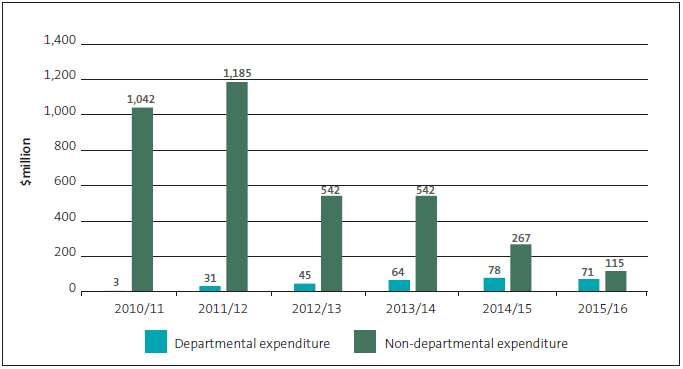
Source: Our analysis of the Canterbury Earthquake Recovery Authority's financial information.
2.16
From March 2011 to June 2015, CERA spent about $3.8 billion. From this, a little over $81 million was spent on administrative and support services, including human resources, finance, information and communications technology, procurement, communications, and corporate and executive services. In the same period, the Treasury, a similar-sized organisation but working in a business-as-usual environment, spent about $63 million on administrative and support services.
2.17
We compared CERA's expenditure on administrative and support services as a proportion of its total organisational running costs (departmental expenditure). In the 2014/15 BASS report, administrative and support costs for small organisations, as a proportion of organisational running costs, ranged from about 5% to about 25%. In 2014/15, CERA's administrative and support services expenditure represented about 39% of departmental expenses.
2.18
Figure 4 shows the different areas of expenditure on administrative and support services. It shows that a significant proportion of the $81 million CERA spent on administrative and support services was on communications (24%) and information services (18%). Communications was an important role for CERA, but, as we describe in Part 3, despite this high level of expenditure, CERA was not as effective in communicating with the community as it intended.
Figure 4
Spending by administrative and support area, 2010/11 to 2014/15
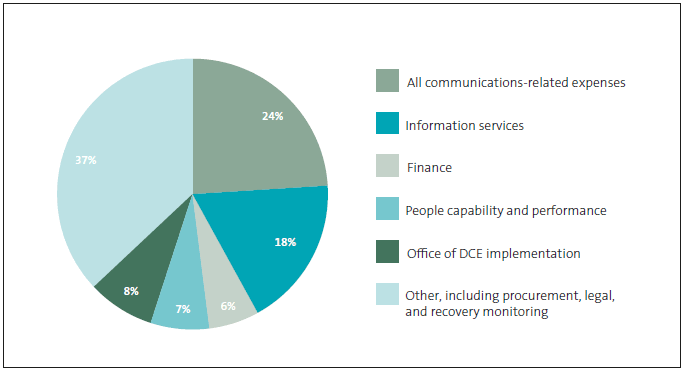
Source: Our analysis of the Canterbury Earthquake Recovery Authority's financial information.
2.19
Figure 5 shows that from 2010/11 to 2014/15 there was a clear pattern of increasing spending in administration and support services, as CERA took on more responsibilities than originally intended. This was driven by an increasing number of full-time equivalent staff (FTEs) in the administrative and support services groups, as CERA grew in size and took on more responsibility for projects and programmes. When CERA was established in March 2011, it was forecast to require 55 FTEs in total, including administrative and support services staff. In June 2013, CERA had 233 FTEs, and by June 2015 there were 331 FTEs.
Figure 5
Annual spending on administrative and support services, 2010/11 to 2014/15
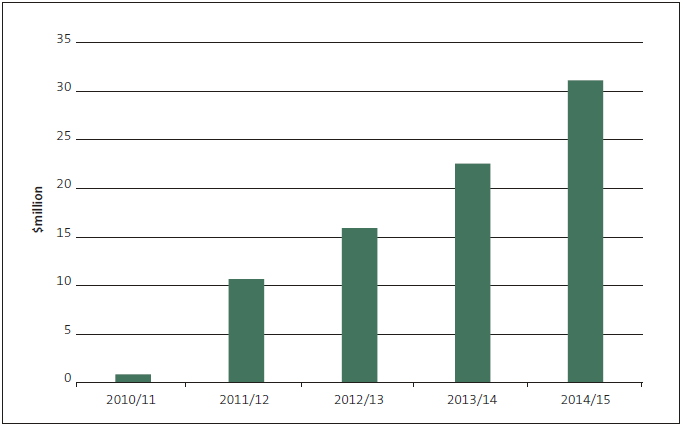
Source: Our analysis of the Canterbury Earthquake Recovery Authority's financial information.
2.20
We compared CERA's spending on managing its finance function and its human resources service with other similar-sized public entities. This was at the upper end of the range of comparable entities, and was above the median for most years. We also compared CERA's spending on communication.
2.21
Communication was an important part of the leadership and co-ordination function of CERA. According to the BASS reports, in 2015 typical communication expenses for a small entity were between $1,500 and $5,500 per employee. CERA's spending on communications greatly exceeded this each financial year, never being less than $20,000 per employee. At its peak in 2014/15, CERA employed 36 staff in the communications function. This function included teams responsible for producing publications, media engagement, and creating and updating the website. The number of communications staff in other small entities ranged from two to eight in 2013/14 and 2014/15.
2.22
CERA's spending on human resources and finance was high when compared with similar-sized entities working in a business-as-usual environment. This is understandable given the operating environment of CERA. As well as departmental spending, the finance team was responsible for overseeing non-departmental expenditure of about $3.7 billion, which involved many complex transactions (including co-funding arrangements) and overseeing multiple projects and programmes. The temporary nature of CERA's role also meant that attracting and retaining staff with the required skills was challenging and required more work by the human resources staff.
2.23
Figure 6 compares the number of finance staff in CERA with the BASS median for similar-sized entities. It shows that CERA's finance function was similar to the range for small entities in BASS. For example, in 2010/11, the highest figure reported by a small entity in the BASS report was 14.25 FTEs. In 2014/15, the highest figure reported was 9.23 FTEs.
Figure 6
Number of staff in the finance function, compared with the BASS median for small entities
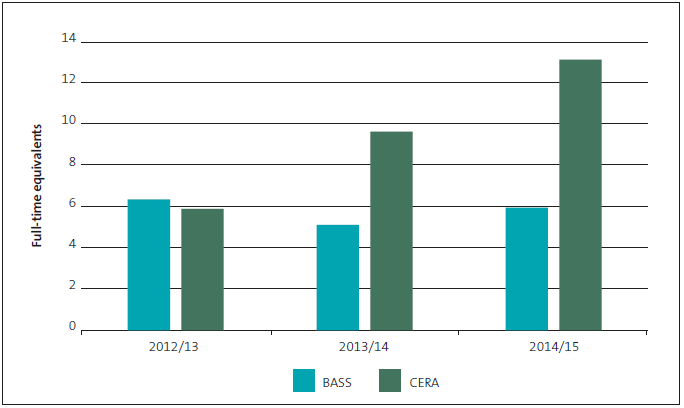
Source: Our analysis of the Canterbury Earthquake Recovery Authority's financial information.
2.24
Figure 7 shows the costs of CERA's finance function per employee were higher than the BASS median for small entities. However, the costs were in the range of expenditure on finance by the entities included in the BASS report. For example, in 2011/12, the highest figure for a small entity was about $7,000 per employee. In 2014/15, the highest figure was about $8,500 per employee.
Figure 7 Cost of the finance function per employee, compared with the BASS median for small entities
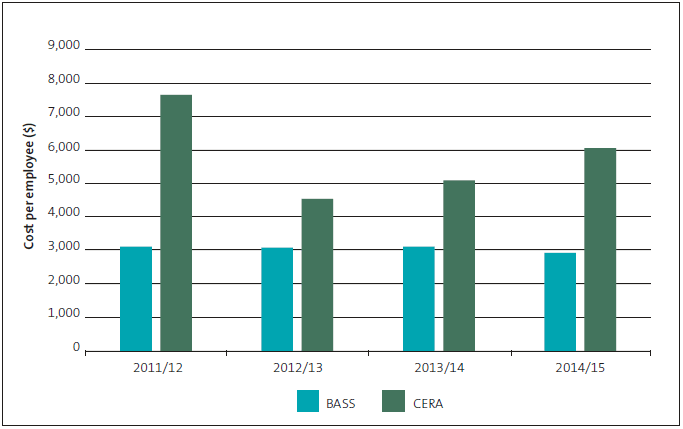
Source: Our analysis of the Canterbury Earthquake Recovery Authority's financial information.
2.25
The spending on CERA's finance function was relatively high. In our view, this was not unreasonable because the finance team had to deal with many complex accounting issues, particularly about land acquisition, funding, and uncertainty about future ownership of assets.
2.26
The quality and effectiveness of CERA's finance function improved over time. In 2011/12, our annual audit identified that CERA needed to improve its financial systems and controls. By the end of 2012/13, these controls were much improved. CERA's financial information systems and controls were rated as "good" by our auditors until CERA became a departmental agency and its finances were consolidated into the Department of the Prime Minister and Cabinet (DPMC). However, CERA incurred unappropriated expenditure in most years, and could have done more to better understand the accounting treatment of transactions.
CERA had more human resources staff than the median for entities of a similar size
2.27
CERA had more staff in human resources compared with the median in the BASS reports (see Figure 8). The figures are much greater for CERA than the entities in the BASS reports in 2013/14 and 2014/15. For example, in 2010/11 the highest figure reported by a small entity through the BASS report was 9.0 FTEs, and in 2014/15 the highest figure reported was 9.3 FTEs.
Figure 8
Number of staff in the human resources function, compared with the BASS median for small entities
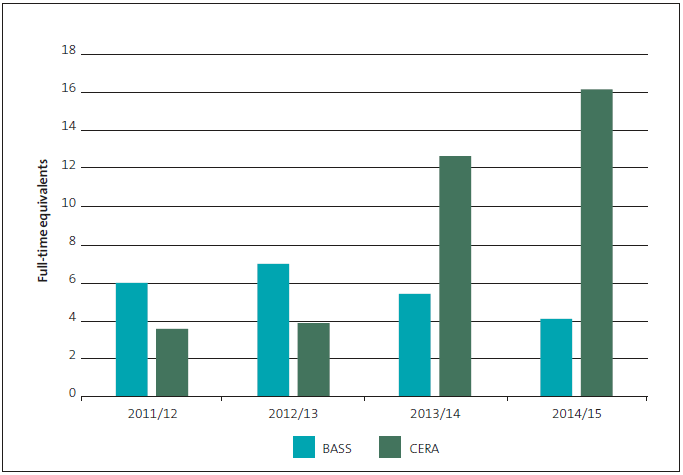
Source: Our analysis of the Canterbury Earthquake Recovery Authority's financial information.
2.28
The costs of the human resources function per employee were higher than the BASS median for small entities (see Figure 9). However, for most years these estimates are on par with the high end of the BASS benchmarks for small entities. For example, in 2011/12, the highest figure for a small entity was about $8,100 per employee. In 2014/15, the highest figure was about $8,300.
Figure 9
Cost of the human resources function per employee, compared with the BASS median for small entities
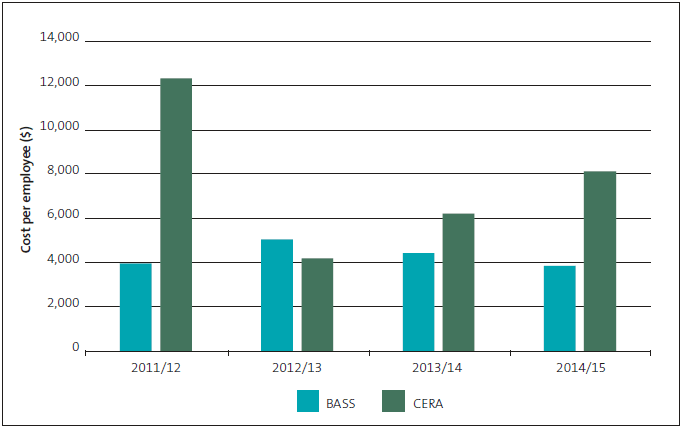
Source: Our analysis of the Canterbury Earthquake Recovery Authority's financial information.
2.29
It is understandable that CERA's spending on human resources was higher compared with entities of a similar size. CERA was operating for a limited time, so recruitment and retention were a constant challenge. The number of human resources staff was influenced by CERA's need for fixed-term and contract staff to meet its changing and diverse functions.
2.30
Many CERA staff faced personal challenges because they had been affected by the earthquakes and were working in a high-pressured environment. CERA took many steps to help ensure staff well-being, and invested time and resources in supporting staff as it planned to wind down and transfer its responsibilities to other agencies. The results of annual staff surveys indicate that this investment was effective, but we note that staff engagement results declined over time. In 2015, 77% of staff were considered engaged compared with 85% in 2014 and 89% in 2013. This pattern is consistent with the recognised phases of recovery. Staff were particularly positive about the support CERA provided for their health and well-being, with 80% of staff in 2015 feeling that the organisation provided sufficient resources and help to assist with their well-being.
2.31
Our analysis of CERA's spending on two of its back-office functions – finance and human resources – shows that CERA's operational spending was higher than the median of other similar-sized public entities. In our view, this was not unreasonable, since CERA was operating in a unique and challenging situation and was responsible for about $3.7 billion of non-departmental expenditure. The spending was not outside of the range of entities included in the BASS reports.
CERA had unappropriated expenditure in most years
2.32
CERA was responsible for managing the appropriations in Vote Canterbury Earthquake Recovery. In most years, there were breaches of appropriation. Some of these breaches were technical in nature and hard to predict or plan for. However, other instances of unappropriated expenditure could have been avoided with greater planning and awareness of the financial consequences of policy decisions.
2.33
Under New Zealand's constitutional and legal system, the Government needs Parliament's approval to:
- make laws;
- impose taxes on people to raise public funds; and
- spend public money.
2.34
As a public entity, CERA was responsible for administering public money approved by Parliament to be spent on the recovery from the Canterbury earthquakes. This meant CERA had to ensure that it:
- did not spend more than what was approved by Parliament; and
- spent public money only on activities approved by Parliament.
2.35
CERA incurred unappropriated expenditure every year, except for 2015/16. The amounts of unappropriated expenditure are set out in Figure 10. The unappropriated expenditure related to the horizontal infrastructure (pipes and roads), the Anchor Projects, and the Red Zones.
Figure 10
Number and value of instances of unappropriated expenditure, 2011/12 to 2015/16
| Financial year | Number of instances | Value |
|---|---|---|
| 2010/11 | 1 | $1,038,958,000 |
| 2011/12 | 4 | $184,293,000 |
| 2012/13 | 3 | $10,141,000 |
| 2013/14 | 7 | $139,670,000 |
| 2014/15 | 5 | $37,049,000 |
| 2015/16 | 0 | $0 |
2.36
CERA worked in a changing and uncertain environment. Some of the decisions made by Cabinet resulted in high levels of spending that had to be undertaken before there was time to seek Parliament's approval. For example, the Government's decision in 2011 to purchase properties in the Red Zones was announced when there was no appropriation available for the spending. CERA incurred this expenditure under the authority of an Imprest Supply Act, which provided the authorisation to incur the expense in advance of Parliamentary authority. In 2015, we reviewed the use of imprest supply for the Red Zones and concluded that it was appropriate and lawful.
2.37
At other times, complex accounting issues, such as the valuation of land that the Crown had purchased in the CBD and the decision to vest ownership of the Bus Interchange to CERA, were hard to predict and led to unappropriated expenditure. However, other instances of unappropriated expenditure by CERA could have been avoided by more timely evaluation of the accounting and appropriation impacts of proposed decisions. Flexible arrangements in funding, such as multi-category appropriations, could help manage the uncertainty in a recovery environment.
Winding down and transferring roles and responsibilities
2.38
In 2012, we reported that the establishment of CERA was linked to the Act. The Act would expire in April 2016 and, at the time, it was intended for CERA to stop operating in April 2016. We noted that it was important for CERA to prepare an effective "exit strategy" to ensure that recovery efforts remained effective after it was disestablished.4
2.39
CERA did not clearly state what it would achieve by the end of its five years. This meant that there was not enough focus on the enduring legacy and consequences of decisions and commitments that CERA was making. In 2014, CERA worked with recovery partners to create a transition plan that sharpened the focus on CERA's legacy and the projects and programmes it was responsible for.
2.40
In 2015, Cabinet announced that CERA would be disestablished in April 2016, and its functions and powers would be transferred to a range of public entities. These included two new entities, Ōtākaro Limited (a Crown-owned company responsible for the Crown's investment in the CBD) and Regenerate Christchurch (a public entity governed by a board made up of appointees from the Crown and Christchurch City Council). CERA's responsibilities have now been successfully transferred to the other entities. Information, knowledge, and skills have been effectively handed over.
2.41
In February 2015, about a year before the formal expiry of the Canterbury Earthquake Recovery Act 2011, CERA became a departmental agency of DPMC. Departmental agencies are a new organisational form in the New Zealand public sector. They are intended to provide for operational functions to be carried out autonomously, while remaining part of a host government department for the purposes of Ministerial and Parliamentary accountability. The objective was to maintain the pace and momentum of recovery activities while smoothly moving responsibilities from CERA to other agencies on the expiry of the Act.
2.42
We were told by former CERA staff and staff from central agencies that establishing CERA as a departmental agency of DMPC helped CERA influence the work of other government departments, and prepare for the transfer of CERA's responsibilities to other agencies. However, integrating CERA into DPMC was challenging and came at a cost. It involved consolidating CERA's financial and performance information with DPMC's in the middle of the financial year. The complexities in consolidating the accounts of CERA into DPMC's annual report meant that DPMC breached its statutory reporting deadline under section 45D of the Public Finance Act 1989.
2.43
In a unique situation, DPMC was consolidating CERA into the host department while working on CERA's disestablishment and transfer of functions. The work stretched the capacity and capability of DPMC, CERA, and staff from the Central Agencies Shared Services, with the latter completing annual report work for the two other central agencies as well as carrying out business as usual.
2.44
The State Services Commission conducted a review of the CERA experience as a departmental agency against the formal legislated framework and relevant policy advice. The State Services Commission is using the findings of this work to update the relevant parts of its machinery of government guidance and advice. In our view, it is important that the results are published so that lessons can be learned and applied to the establishment of departmental agencies in the future.
2.45
After the announcement of its disestablishment, CERA established a change management office to prepare for and manage the handover of responsibilities to other agencies. The change management office also worked with CERA staff to help them prepare for the transition, providing counselling, training, and support for finding employment after CERA was disestablished. Former CERA staff told us that this process was managed well. To date, the transfer of functions to other agencies appears to have been successful. Evidence from our annual audits of inheriting agencies in 2016 has not shown any significant issues with the transfer of roles and responsibilities to other public sector organisations.
2.46
CERA carried out an extensive learning and legacy exercise to identify the main lessons from its five years, and has made an effective contribution to the wider learning and legacy programme that was being managed by DPMC. CERA's learning and legacy work is available on a new website hosted by DPMC (see eqrecoverylearning.org).
Lessons for the future
2.47
In our view:
- The State Services Commission needs to consider the most appropriate organisational type of any future recovery agency, the benefits and costs of each organisational type, the situations in which they should be used, and how long a recovery agency should remain in place.
- The Ministry of Civil Defence and Emergency Management and the State Services Commission need to prepare a response plan that will enable a future recovery agency to be established quickly and effectively. They need to update the plan regularly and include criteria for when an agency would be established. The response plan needs to include service-level agreements to prepare for the quick establishment of core corporate services.
- There needs to be clarity about what a recovery agency should achieve by the end of its lifetime. This should be expressed in a performance framework with realistic targets, and be regularly reported on.
- To manage uncertainty in a disaster recovery, a recovery agency needs to have flexible arrangements for funding and staffing. For example, it might need to use multi-year and category appropriations, and a mixture of fixed-term and short-term staff.
- A recovery agency needs effective financial and management controls from the start. The early stage of the recovery is when there is the greatest risk and opportunity for fraudulent activities and inappropriate spending of public funds.
2: Administrative and support service functions include human resources, finance, and communications.
3: CERA is considered a small agency, which is described in the BASS 2014/15 report as an agency with fewer than 500 full-time equivalent staff, organisational running costs of less than $100 million, and mainly a "policy, regulatory or compliance focus" and/or mainly centralised services.
4: Office of the Auditor-General (2012), Roles, responsibilities, and funding of public entities after the Canterbury earthquakes, pages 19 and 23.

